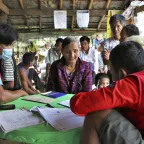Professional Standards for Protection Work
… edition also seeks to clarify how counter-terrorism legislation may affect the activities …
… edition also seeks to clarify how counter-terrorism legislation may affect the activities …
… comparative use of force IHL and counter-terrorism operations Engagement with non-state …

… action challenged by national counter-terrorism measures; • The dilemma of the … with armed actors; • War reporting; • Terrorism and non-international armed …

… the lines between armed conflict and terrorism, with potentially adverse effects on IHL. While the legal frameworks governing terrorism and IHL have some common ground – IHL … and international conventions dealing with terrorism – the two legal regimes remain …

… the respect of basic principles in counter terrorism operations and on asymmetric warfare. … elaborate sanctions procedures and counter-terrorism measures. Humanitarian principles …

… apply in contemporary conflicts, in which terrorism, siege warfare, cyber warfare and … law. When it comes to modern challenges like terrorism and asymmetrical warfare, these are …
… conflicts - IHL and non-State armed groups - terrorism, counterterrorism measures, and IHL - …
… negative impact of sanctions and counter-terrorism measures on humanitarian aid. These … mitigate, the humanitarian impact of counter-terrorism measures by putting in place …

… that some states have adopted counter-terrorism laws, which can sometimes interfere … IHL committees help ensure that counter-terrorism frameworks are consistent and … to have coherent and comprehensive counter-terrorism frameworks that meet national …

The ICRC takes the issue of misinformation, disinformation, and hate speech (MDH) during armed conflict seriously and is dedicated to finding effective ways to address this problem and its …
Try one of the following resources:
Created in 1863, the ICRC library, alongside the ICRC archives, provides an indispensable documentary reference on the organization itself and international humanitarian law.
International humanitarian law is based on a number of treaties, in particular the Geneva Conventions of 1949 and their Additional Protocols, and a series of other instruments.
Customary international humanitarian law consists of rules that come from "a general practice accepted as law" and that exist independent of treaty law.